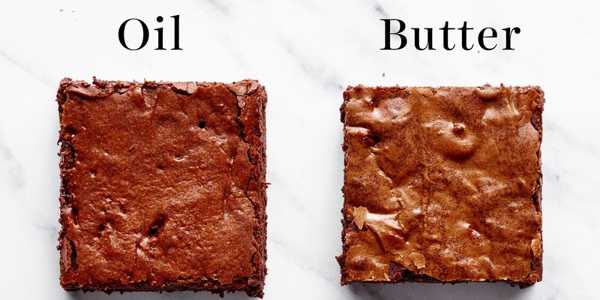5 Reasons Your Brownies Turn Out Dry (And How to Fix Them)
Brownies are a beloved treat everywhere. People love to bake them because the ingredients are very simple. But sometimes, they turn out dry and don't taste good.
Brownies are a beloved treat everywhere. People love to bake them because the ingredients are very simple. But sometimes, they turn out dry and don't taste good.
But that does not mean this is your fault. Baking is all about science. You have to consider many factors while baking something so that the results can be according to your needs.
These factors include a good recipe, the temperature of your oven, the ratios of ingredients you use, etc. It's frustrating when you invest your effort to make something, but the results are not according to your plan.
But no worries! We'll discuss why your brownies become dry and the reasons behind it. You will get all the know-how to bake perfect brownies.
So, let's start learning!
5 Reasons Your Brownies Turn Out Dry & And How to Fix Them

Let's tackle the common issues that lead to dryness. By identifying them, you'll be better equipped to avoid these culprits in your next batch.
Here are the top five reasons your brownies might be turning out dry, along with practical solutions for each:
1. Overbaking
Overbaking is the most frequent culprit behind dry brownies. When brownies stay in the oven too long, moisture escapes, leaving you with a dry, crumbly texture instead of a fudgy delight.
Fix: Check your brownies 5 minutes before the recipe's suggested baking time. Look for set edges and a slightly wobbly center.
A toothpick inserted in the center should come out with a few moist crumbs, not completely clean. Remember, brownies continue to set as they cool.
2. Incorrect Oven Temperature
Oven temperatures can be unreliable. If your oven runs hotter than the set temperature, it can lead to overbaking and dry brownies.
Fix: Invest in an oven thermometer for accuracy. Place it in different spots to check for hot spots. Adjust your baking temperature or time based on the actual oven temperature.
A slightly lower temperature (around 325°F instead of 350°F) can help maintain moisture for brownies.
3. Using Too Much Flour
Excess flour absorbs too much moisture, resulting in a dry, cakey texture rather than a rich, fudgy one. If you measure incorrectly, it's easy to accidentally use too much flour.
Fix: Use the spoon-and-level method when measuring flour. Gently spoon flour into your measuring cup, then level it off with a straight edge.
Avoid scooping directly with the measuring cup, which can pack up to 25% more flour. Consider using a kitchen scale for ultra-precise measurements.
4. Lack of Fat
Fat is crucial for moist brownies. Butter and oil contribute to that rich, fudgy texture we all love. Not enough fat can lead to dryness and a less satisfying mouthfeel.
Fix: Follow your recipe's fat measurements precisely. If substituting ingredients, ensure you're maintaining the right fat content.
Consider using melted butter instead of oil for extra richness. Some bakers swear by adding an extra egg yolk for increased moisture and richness.

5. Overmixing the Batter
While it might seem counterintuitive, overmixing your brownie batter can lead to dryness. Excessive mixing incorporates too much air, resulting in a drier, more cake-like texture.
Fix: Mix your batter until the ingredients are just combined. A few small lumps are perfectly fine. When adding dry ingredients, fold them gently with a spatula rather than using an electric mixer.
This gentle approach maintains a dense, fudgy texture by preventing excess air incorporation.
Enjoy Perfect, Moist Brownies Every Time
With these tips in hand, it is about time to apply them. No more getting disappointed by dry and bland brownies; experience the moist and flavorful brownies you always wanted.
Take more time on the baking process, follow the measurements of the ingredients, and avoid over-mixing. You will have a feel for what perfect brownies are.
Why wait? The next batch of brownies you prepare could be your best. Picture a piece of chocolate bliss, soft and rich. This satisfaction is achievable.
Fire up your oven, collect your ingredients, and prepare to be amazed and possibly amaze others with your newfound brownie knowledge. Happy baking!
Frequently Asked Questions
Q: How can I prevent my brownies from overbaking?
Ans: Start checking your brownies 5 minutes before the recipe's suggested time. Look for set edges and a slightly wobbly center. A toothpick should come out with a few moist crumbs, not completely clean.
Q: What's the best way to measure flour for brownies?
Ans: Use the spoon-and-level method. Gently spoon flour into your measuring cup, then level it off with a straight edge. Don't scoop directly with the cup, as this can pack in too much flour.
Q: Can I use oil instead of butter in brownies?
Ans: Yes, oil can make brownies moist. However, butter adds flavor. If substituting, use about 20% less oil than the butter called for in the recipe. For best results, follow the recipe closely.
Q: Why do my brownies turn out like cake?
Ans: Over Mixing the batter or using too much flour can make brownies cake-like. Mix ingredients until just combined, and measure flour carefully. Also, check that you're not using too much leavening agent.